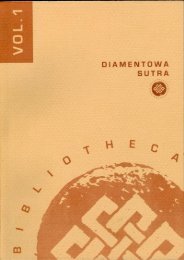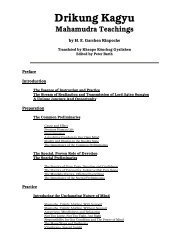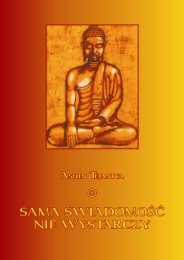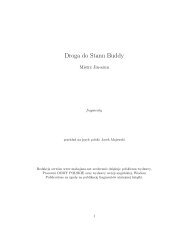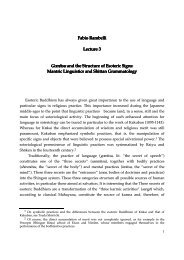My Zazen Sankyu (san = to participate humbly; kyu ... - Valley Zendo
My Zazen Sankyu (san = to participate humbly; kyu ... - Valley Zendo
My Zazen Sankyu (san = to participate humbly; kyu ... - Valley Zendo
Create successful ePaper yourself
Turn your PDF publications into a flip-book with our unique Google optimized e-Paper software.
<strong>My</strong> <strong>Zazen</strong> <strong>San<strong>kyu</strong></strong><br />
(<strong>san</strong> = <strong>to</strong> <strong>participate</strong> <strong>humbly</strong>; <strong>kyu</strong> = <strong>to</strong> inquire or explore)<br />
Rev. Issho Fujita, <strong>Valley</strong> <strong>Zendo</strong>, Massachusetts<br />
with assistance from Tansetz Shibata and Tesshin Brooks<br />
Notebook (5)<br />
Fragmentary Thought XV <br />
In the summer of 1979 when I was a Ph.D. student at Tokyo University, I hosted a<br />
weekend study retreat for a group of my fellow students from the developmental<br />
psychology department. We left the heat and congestion of Tokyo for the cool mountain<br />
air of Komoro, in Nagano prefecture. One afternoon we <strong>to</strong>ok a walk in the Ruins of<br />
Komoro Castle Memorial Park. As we were walking we saw a strange old man, sitting<br />
perfectly straight and still, under his tent in front of a portable charcoal brazier. His<br />
dignified bearing was unmistakable. We watched him for a moment. I was wondering if<br />
this old fellow was sitting zazen, when he quickly glanced over at us. He plucked a leaf<br />
from a nearby tree limb. With two fingers he pressed it flat against his lips and whistled<br />
a simple, haunting melody. We were not quite sure what <strong>to</strong> do, so we just continued on<br />
our way. Someone in our group said “He is playing a grass flute. Very unusual for a<br />
homeless beggar...”<br />
The sight and sound of this old man made a strong impression on me, although I didn't<br />
know why at the time. Back in Tokyo, one evening after our Noguchi exercise class, I<br />
mentioned him <strong>to</strong> some friends of mine. One woman seemed <strong>to</strong> recognize the man I was<br />
talking about. “Really! It sounds like the old monk my uncle sponsors. His name is<br />
Sodo Yokoyama. He is a disciple of the great Roshi, Kodo Sawaki. I have seen his<br />
calligraphy and his writing. Everyone calls him “Grass Flute Zenji”.”<br />
“I wonder if that was him. I wish I would have spoken <strong>to</strong> him...” I was very<br />
disappointed that I missed that opportunity <strong>to</strong> talk <strong>to</strong> the old monk, but I was determined<br />
<strong>to</strong> go back <strong>to</strong> Komoro during the next study retreat, the following August, and see him.<br />
Sad <strong>to</strong> say, he died several months later, and I missed my chance <strong>to</strong> speak with him,<br />
forever.<br />
Karma works in mysterious ways... During the first summer that I entered Antaiji temple<br />
I met Yokoyama Roshi's patron, Masakichi Nakamura, the man my Tokyo friend had<br />
mentioned. He and his children lived in Tokyo, but were visiting Antaiji for a while that<br />
summer. I was a new monk and I was assigned the job of baby-sitting the children from<br />
time <strong>to</strong> time, so after a while I became well acquainted with the family.<br />
From then on whenever I had occasion <strong>to</strong> go <strong>to</strong> Tokyo, I was invited <strong>to</strong> stay at the<br />
Nakamuras' home. Over the course of time Mr. Nakamura showed me some
extraordinary examples of the calligraphy and letters of Sawaki Roshi and Yokoyama<br />
Roshi. And he <strong>to</strong>ld me many s<strong>to</strong>ries about those great Zen masters, about events he had<br />
witnessed himself or had heard about. I cannot tell you how much, as a novice monk, I<br />
was inspired by listening <strong>to</strong> the s<strong>to</strong>ries of these great Roshis, both of whom were so<br />
intimately connected with Antaiji.<br />
I moved <strong>to</strong> <strong>Valley</strong> <strong>Zendo</strong> in the United States in 1987, and in 1990 I returned <strong>to</strong> Japan for<br />
the first time in three years. On that trip I visited Yokoyama Roshi's memorial<br />
monument, at the Ruins of Komoro Castle Memorial Park, with my teacher Koho<br />
Watanabe Roshi. On the same trip we visited Joko Shibata, Yokoyama Roshi's only<br />
disciple, who shared his memories of Yokoyama Roshi with us.<br />
I am telling you about these things not simply <strong>to</strong> share my personal recollections with<br />
you, but <strong>to</strong> introduce you <strong>to</strong> the life and thought of the extraordinary monk Sodo<br />
Yokoyama Roshi (1907-1980). I would like <strong>to</strong> acquaint you with this man with whom I<br />
share strong karmic ties, and <strong>to</strong> introduce you <strong>to</strong> the zazen of the Zen master who coined<br />
the phrase “zaso korin” -- <strong>Zazen</strong> posture is descended from heaven.<br />
Yokoyama Roshi's essays, letters, calligraphy, and songs -- with his own words and<br />
music -- are his “footnotes <strong>to</strong> zazen.” They are collected in four books: I Stand By The<br />
Tall Tree, The Grass Flute Master - The Man and His Works, The Collected Songs of the<br />
Grass Flute Master, and The Collected Songs of Sodo Yokoyama.<br />
Since I did not have a chance <strong>to</strong> speak with or practice with Yokoyama Roshi directly, I<br />
can only infer his understanding of zazen from the works he left behind. Reading his<br />
books I can see that Yokoyama Roshi thoroughly assimilated the teachings of Sawaki<br />
Roshi, and sat shikantaza single-mindedly. It is clear <strong>to</strong> me that because of his sincere<br />
desire <strong>to</strong> transmit the practice of zazen and the Buddha way correctly <strong>to</strong> future<br />
generations, he deepened his practice continually.<br />
That Yokoyama Roshi truly inherited the tradition of Sawaki Roshi is evident both in his<br />
<strong>to</strong>tal dedication <strong>to</strong> the practice of zazen and in his fertility as a crea<strong>to</strong>r of his unique<br />
"footnotes <strong>to</strong> zazen." The list of Yokoyama Roshi's coined expressions is long, and it<br />
conveys clearly how well he unders<strong>to</strong>od, absorbed and practiced zazen. Some of his<br />
expressions are aphorisms, some are technical terms. Both help <strong>to</strong> communicate his<br />
understanding in a fresh, lucid way. His expressions are highly unusual, even in Japanese.<br />
Among the expressions he created are:<br />
“zaso yuishiki” - zazen is all about form<br />
“bannsho rinen” - phenomena are separate from thought<br />
“miyabi no zazen” - the zazen of grace<br />
“zaso miho<strong>to</strong>ke” - zazen posture is Buddha
“hishi no ryo” - the substance of non-thinking<br />
There are many more. Of all his expressions the statement “zaso korin” (“zazen posture<br />
has descended from heaven”) most completely reveals his profound understanding of<br />
zazen.<br />
Yokoyama Roshi often spoke of the time when he was about 28 years old, before he was<br />
ordained a monk. He was sitting zazen alone in the mountains when a phea<strong>san</strong>t suddenly<br />
appeared. The phea<strong>san</strong>t s<strong>to</strong>pped and stared at him. Had he been standing the phea<strong>san</strong>t<br />
surely would have run away. But since he was sitting in zazen, the phea<strong>san</strong>t must not<br />
have been able <strong>to</strong> tell he was a human being, so the phea<strong>san</strong>t stared at him, perhaps<br />
pondering what he was. Yokoyama always said that from his "phea<strong>san</strong>t experience" he<br />
learned, intuitively, what shikantaza really is.<br />
His teacher, Kodo Sawaki Roshi, had a very similar experience when he was a young<br />
man. When Kodo Sawaki was seventeen years old, still a novice and not yet fully<br />
ordained, he was sent out <strong>to</strong> help perform a service at a nearby temple. He had only<br />
recently learned <strong>to</strong> sit zazen. And when he was finished with his ceremonial duties, he<br />
sat zazen alone in his room. Suddenly an old woman burst in<strong>to</strong> the room. This woman<br />
worked for the temple, supervising the work of the young novices, and she had a habit of<br />
driving this particular young monk very harshly. Assuming the room was empty she slid<br />
open the sliding door and burst in. As soon as she saw him sitting in full lotus, she<br />
pressed her hands <strong>to</strong>gether and bowed deeply before his zazen posture. She bowed more<br />
fervently than if she were bowing <strong>to</strong> a Buddha statue. She chanted Namu Shakamuni<br />
Butsu, Namu Shakamuni Butsu (Homage <strong>to</strong> Shakyamuni Buddha). Since the young<br />
novice had no academic training in Buddhism all, he had no theoretical understanding of<br />
what zazen was all about. Nevertheless this woman, who had been treating him like a<br />
slave every day, was now worshipping him as she would a Buddha.<br />
Sawaki Roshi said that this early experience of the sacred mystery of zazen posture was<br />
decisive in forming his lifelong faith in zazen. It is significant that both of these great<br />
Roshis, as young monks, before their formal ordination, had insight in<strong>to</strong> zazen posture as<br />
something that is beyond individual consciousness. Sawaki Roshi and Yokoyama Roshi<br />
both agreed that “The Buddha way is the faith that zazen posture is Buddha. When we<br />
refer <strong>to</strong> the qualities of hishiryo (beyond thinking) and munen muso (no thought, no<br />
image) we mean that sitting posture is beyond thinking and has no thought, no image, not<br />
that we ourselves are. We will never be beyond thinking, nor have no thought, no image,<br />
as long as we live. What we can do is sit with the faith that zazen posture itself is<br />
Buddha, that zazen posture itself is beyond thinking, with no thought, no image.<br />
Shikantaza is only concerned with zazen posture. <strong>Zazen</strong> posture is the supreme way for<br />
human beings <strong>to</strong> be.”<br />
Yokoyama Roshi's faith in zazen posture was extremely profound. He said "<strong>Zazen</strong> and<br />
the universe are congruent. It was zazen posture as the whole universe that descended <strong>to</strong><br />
the foothills of the Himalayas (where the Buddha was born), as if <strong>to</strong> say “This is the way<br />
I am.” Briefly we can say “zaso korin: zazen posture has descended from heaven. We
tend <strong>to</strong> think that we are sitting zazen. This is not the case. The entire universe is sitting<br />
zazen.”<br />
Yokoyama Roshi is saying that in zazen we can rely upon sitting posture alone. He is<br />
saying that Buddhism as the source of wisdom is not essential. When there is nothing but<br />
zazen posture, a phea<strong>san</strong>t will s<strong>to</strong>p and stare at zazen. <strong>Zazen</strong> is just <strong>to</strong> sit. If we sit, that<br />
is all there is. Thus, zazen is available <strong>to</strong> everyone. Simply instructing people on the<br />
elements of the proper posture of zazen - fold your legs like this, hold your hands like<br />
this, stretch your back, pull in your chin - is enough. Yokoyama Roshi was quoting the<br />
Bible (Matthew 5-37) when he said: “Say yes when you mean yes, and no when you<br />
mean no. Anything beyond this comes from the evil one.”<br />
In the Annual Collected Essays, published by Antaiji in 1976, Yokoyama Roshi wrote:<br />
“Let me restate zaso korin in slightly different words: A flower blooming or a human<br />
being thinking are events which occur on a cosmic scale. If we look at human beings<br />
from the point of view of the stars, we can see that human beings are just part of the<br />
universe. Trees, flowers, human beings and human action all are connected <strong>to</strong> the whole<br />
universe.” He is telling us that in zazen we adopt a posture in which we accept the fact<br />
that we are seamlessly connected with the whole universe; we immediately and naturally<br />
conform <strong>to</strong> it with our own body-mind.<br />
He is also saying that a person sitting and breathing in full lotus posture is the grass, a<br />
tree, a bird, a life - the person is the world, the person is “keisei <strong>san</strong>shiki” the voice of<br />
valleys, the form of the mountains. The universe itself.<br />
This may just sound grandiose, like a fantasy far removed from the reality of daily life.<br />
However, it will be helpful <strong>to</strong> recall that Shigeo Miki (cf. Notebook 4) asserted<br />
essentially the same idea, drawing on evidence from a field of exploration very different<br />
from Buddhism. I personally feel a very strong need <strong>to</strong> reconsider Buddhism along the<br />
lines indicated by Yokoyama Roshi and Shigeo Miki.<br />
<strong>Zazen</strong> as zaso korin can be practiced by anyone in the world. Anyone who actually<br />
practices zaso korin can immediately experience and understand it. The rest of one's life,<br />
Yokoyama Roshi said, can be lived in a way that is harmonious with the traditions and<br />
character of one's country.<br />
The great challenge is <strong>to</strong> get practitioners <strong>to</strong> understand and accept that it is zazen posture<br />
that is precious. It is not your own brain or personality that are most valuable. For<br />
someone like me, who's life is centered on zazen, the last 22 years of Yokoyama Roshi's<br />
life spent at the Ruins of Komoro Castle Memorial Park - he called the place the Blue<br />
Sky Temple on Sunshine Mountain - is a beacon lighting my way. I am deeply grateful<br />
for the karmic connections that allowed me <strong>to</strong> see Yokoyama Roshi, even though it was<br />
only for five minutes or so, before I became a monk at Antaiji, the temple with which he<br />
was so closely connected.



![Shushogi, Dogen Zenji [PDF] - Mahajana.net](https://img.yumpu.com/50921105/1/190x219/shushogi-dogen-zenji-pdf-mahajananet.jpg?quality=85)


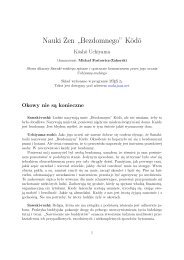

![wywiadu z Murakami Kosho Roshim [PDF] - Buddyzm w Polsce i na ...](https://img.yumpu.com/45809746/1/184x260/wywiadu-z-murakami-kosho-roshim-pdf-buddyzm-w-polsce-i-na-.jpg?quality=85)
